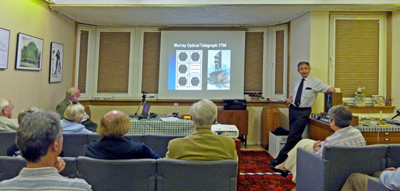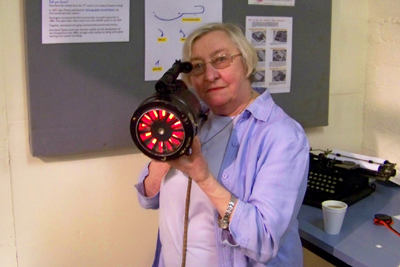
Photo by Peter GM4DTH
There was a special meeting of the Lothians Radio Society at the Museum of Communication in Burntisland on 28th September 2011. Prof. Tom Stevenson, Chairman of the MOC, assisted by Dorothy Brankin, Marion McLean and Dr. Raymond Parks, presented "WWW - Words, Wires, Waves and the World Wide Web". They described how science has transformed the way we communicate over the last 400 years - Words from printing and the speaking-tube to shorthand and typing - Wires from the electric telegraph to telephone exchanges - Waves from the crystal set and television to the Blackberry and Bluetooth - and the World Wide Web from Amstrad and the Spectrum to the iPod and webcam. This was a joint meeting of the LRS and the Glenrothes & District Amateur Radio Club with an attendance of 20. Peter Dick GM4DTH proposed a vote of thanks on behalf of all the attendees. After the presentation we visited the current MOC exhibition with this theme.

Prof. Tom Stevenson presented this wide-ranging talk on the development of communication by mankind.

Marion McLean and Prof. Stevenson demonstrated longitudinal sound waves using a Slinky spring.

Prof. Stevenson tested the sound frequency responses of the audience using this audio oscillator.

Dr. Raymond Parks demonstrated the harmonic content of different sounds using his laptop-based audio spectrum analyser, which he used to teach accoustics to his music students.

Dorothy Brankin, along with Marion McLean, sent Semaphore messages across the room.

Prof. Stevenson presented a definition of the "ideal" personal communicator, which sounded very modern, but he revealed that it had been proposed in 1954 by the far-sighted President of Bell Laboratories.

After the presentation we were treated to a tour of the "WWW" 2011 exhibition in the museum.

Dorothy Brankin demonstrated a morse code signal lamp.

The museum has several examples of mechanical telegraphs. This is a model of an Admirality Shutter (Murray Optical) Telegraph.

This is a model of a Wheatstone telegraph of the 1840s, made by Harry Matthews, the founder of the MOC. It required a 5-conductor cable, and provided essential railway signalling.

The MOC has some beautiful examples of early telephones ...

... and a collection of vintage television receivers, including a Baird mechanical set and early CRT receivers.

The Museum of Communication has a working Amateur Radio station.
LRS member Stewart GM4ZOA met members of the MOC and the Glenrothes & District Amateur Radio Club.
L-R: Ian GM4DEX, John GM4AQO, Stewart GM4ZOA, Ken GM3YBQ.

